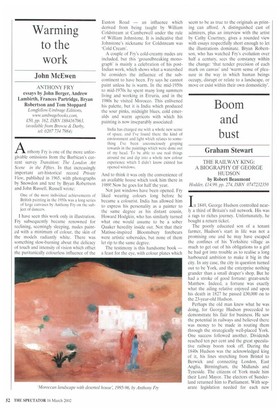Warming to the work
John McEwen
ANTHONY FRY essays by John Berger, Andrew Lambirth, Frances Partridge, Bryan Robertson and Tom Stoppard Longfellow/Umbrage Editions, www.umbragebooks.corn, £50, pp. 162, ISBN 1884167063, (available from Browse & Darby, tel: 0207 734 7984) Anthony Fry is one of the more unforgivable omissions from the Barbican's current survey Transition: The London Art Scene in the Fifties. In that increasingly important art-historical record Private View, published in 1965, with photographs by Snowdon and text by Bryan Robertson and John Russell. Russell wrote:
One of the most individual achievements of British painting in the 1950s was a long series of large canvases by Anthony Fry on the subject of dancers.
I have seen this work only in illustration. Fry subsequently became renowned for reclining, seemingly sleeping, nudes painted with a minimum of colour, the skin of the models radiantly white. There was something slow-burning about the delicacy of touch and intensity of vision which offset the puritanically colourless influence of the Euston Road — an influence which derived from being taught by William Coldstream at Camberwell under the rule of William Johnstone. It is indicative that Johnstone's nickname for Coldstream was 'Cold Cream'.
A couple of Fry's cold-creamy nudes are included, but this 'groundbreaking monograph' is mainly a celebration of his postIndian work, which shows what a watershed he considers the influence of the subcontinent to have been. Fry says he cannot paint unless he is warm. In the mid-1950s to mid-1970s he spent many long summers living and working in Etruria, and in the 1980s he visited Morocco. This enlivened his palette, but it is India which produced the sour pinks, midnight blues, cold emeralds and warm apricots with which his painting is now inseparably associated:
India has charged me with a whole new sense of space, and I've found there the kind of environment and light which relates to something I've been unconsciously groping towards in the paintings which were done out of my head. To be able to use real things around me and dip into a whole new colour experience which I didn't know existed has opened windows.
And to think it was only the convenience of an available house which took him there in 1989! Now he goes for half the year.
Not just windows have been opened. Fry liked wearing colours long before he became a colourist. India has allowed him to express his personality as a painter to the same degree as his distant cousin, Howard Hodgkin, who has similarly turned what one would assume to be a sober Quaker heredity inside out. Not that their Matisse-inspired Bloomsbury forebears were artistic sobersides, but none of them let rip to the same degree.
The testimony is this handsome book — a feast for the eye, with colour plates which
seem to be as true to the originals as printing can afford. A distinguished cast of admirers, plus an interview with the artist by Cathy Courtney, gives a rounded view with essays respectfully short enough to let the illustrations dominate. Bryan Robertson, who has watched Fry's evolution over half a century, sees the constancy within the change: 'that tender precision of each mark on canvas' and 'warm sense of pleasure in the way in which human beings occupy, disrupt or relate to a landscape, or move or exist within their own domesticity'.
















































































 Previous page
Previous page